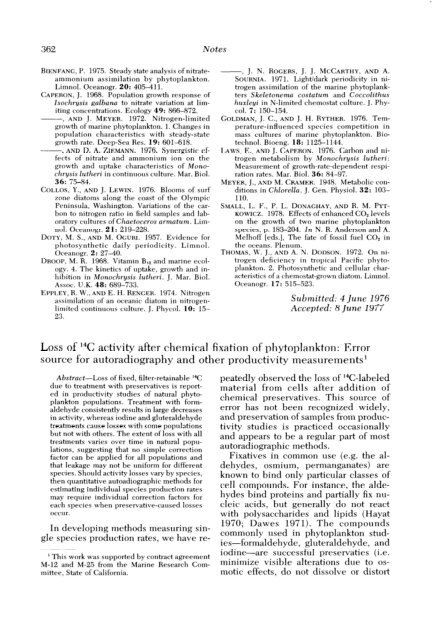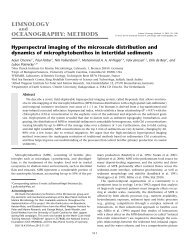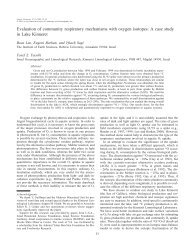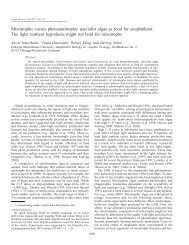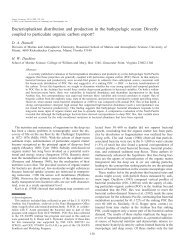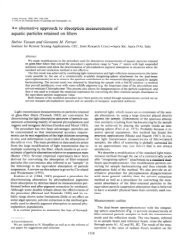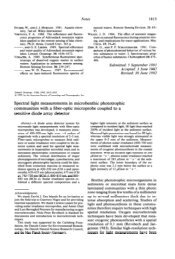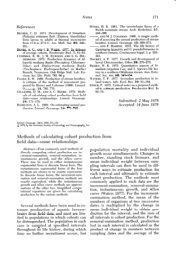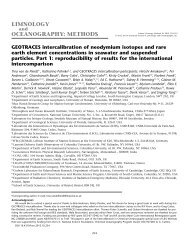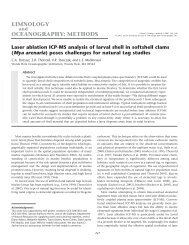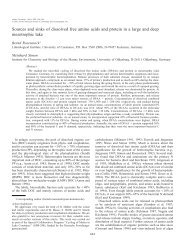SILVER, MARY WILCOX, AND PETER J. DAVOLL. Loss of ... - ASLO
SILVER, MARY WILCOX, AND PETER J. DAVOLL. Loss of ... - ASLO
SILVER, MARY WILCOX, AND PETER J. DAVOLL. Loss of ... - ASLO
- TAGS
- wilcox
- aslo
- www.aslo.org
Create successful ePaper yourself
Turn your PDF publications into a flip-book with our unique Google optimized e-Paper software.
362 Notes<br />
BIENFANG, P. 1975. Steady state analysis <strong>of</strong> nitrate-<br />
ammonium assimilation by phytoplankton.<br />
Limnol. Oceanogr. 20: 405411.<br />
CAPERON, J. 1968. Population growth response <strong>of</strong><br />
Isochrysis galbana to nitrate variation at lim-<br />
iting concentrations. Ecology 49: 866-872.<br />
-> <strong>AND</strong> J. MEYER. 1972. Nitrogen-limited<br />
growth <strong>of</strong> marine phytoplankton. 1. Changes in<br />
population characteristics with steady-state<br />
growth rate. Deep-Sea Res. 19: 601-618.<br />
-, <strong>AND</strong> D. A. ZIEMANN. 1976. Synergistic ef-<br />
fects <strong>of</strong> nitrate and ammonium ion on the<br />
growth and uptake characteristics <strong>of</strong> Mono-<br />
chrysis Zutheri in continuous culture. Mar. Biol.<br />
36: 75-84.<br />
COLLOS, Y., <strong>AND</strong> J. LEWIN. 1976. Blooms <strong>of</strong> surf<br />
zone diatoms along the coast <strong>of</strong> the Olympic<br />
Peninsula, Washington. Variations <strong>of</strong> the car-<br />
bon to nitrogen ratio in field samples and lab-<br />
oratory cultures <strong>of</strong> Chaetoceros armatum. Lim-<br />
nol. Oceanogr. 21: 219-228.<br />
DOTY, M. S., <strong>AND</strong> M. OGURI. 1957. Evidence for<br />
photosynthetic daily periodicity. Limnol.<br />
Oceanogr. 2: 2740.<br />
DROOP, M. R. 1968. Vitamin BIz and marine ecol-<br />
ogy. 4. The kinetics <strong>of</strong> uptake, growth and in-<br />
hibition in Monochrysis Zutheri. J. Mar. Biol.<br />
Assoc. U.K. 48: 689-733.<br />
EPPLEY, R. W., <strong>AND</strong> E. H. RENGER. 1974. Nitrogen<br />
assimilation <strong>of</strong> an oceanic diatom in nitrogen-<br />
limited continuous culture. J. Phycol. 10: 15-<br />
23.<br />
-, J. N. ROGERS, J. J. MCCARTHY, <strong>AND</strong> A.<br />
SOURNIA. 1971. Light/dark periodicity in ni-<br />
trogen assimilation <strong>of</strong> the marine phytoplank-<br />
ters Skeletonema costatum and Coccolithus<br />
huxleyi in N-limited chemostat culture. J. Phy-<br />
col. 7: 150-154.<br />
GOLDMAN, J. C., <strong>AND</strong> J. H. RYTHER. 1976. Tem-<br />
perature-influenced species competition in<br />
mass cultures <strong>of</strong> marine phytoplankton. Bio-<br />
technol. Bioeng. 18: 1125-l 144.<br />
LAWS, E., <strong>AND</strong> J. CAPERON. 1976. Carbon and ni-<br />
trogen metabolism by Monochrysis lutheri:<br />
Measurement <strong>of</strong> growth-rate-dependent respi-<br />
ration rates. Mar. Biol. 36: 84-97.<br />
MEYER, J., <strong>AND</strong> M. CRAMER. 1948. Metabolic con-<br />
ditions in Chlorella. J. Gen. Physiol. 32: 103-<br />
110.<br />
SMALL, L. I?., P. L. DONAGHAY, <strong>AND</strong> R. M. PYT-<br />
KOWICZ. 1978. Effects <strong>of</strong> enhanced COZ levels<br />
on the growth <strong>of</strong> two marine phytoplankton<br />
species, p. 183-204. Zn N. R. Anderson and A.<br />
Melh<strong>of</strong>f [eds.], The fate <strong>of</strong> fossil fuel CO, in<br />
the oceans. Plenum.<br />
THOMAS, !4'. J., <strong>AND</strong> A. N. DODSON. 1972. On ni-<br />
trogen deficiency in tropical Pacific phyto-<br />
plankton. 2. Photosynthetic and cellular char-<br />
acteristics <strong>of</strong> a chemostat-grown diatom. Limnol.<br />
Oceanogr. 17: 515-523.<br />
Submitted: 4 June 1976<br />
Accepted: 8 June 1977<br />
<strong>Loss</strong> <strong>of</strong> 14C activity after chemical fixation <strong>of</strong> phytoplankton: Error<br />
source for autoradiography and other productivity measurements1<br />
Abstract-<strong>Loss</strong> <strong>of</strong> fixed, filter-retainable 14C<br />
due to treatment with preservatives is report-<br />
ed in productivity studies <strong>of</strong> natural phyto-<br />
plankton populations. Treatment with form-<br />
aldehyde consistently results in large decreases<br />
in activity, whereas iodine and gluteraldehyde<br />
treatments cause losses with some populations<br />
but not with others. The extent <strong>of</strong> loss with all<br />
treatments varies over time in natural popu-<br />
lations, suggesting that no simple correction<br />
factor can be applied for all populations and<br />
that leakage may not be uniform for different<br />
species. Should activity losses vary by species,<br />
then quantitative autoadiographic methods for<br />
estimating individual species production rates<br />
may require individual correction factors for<br />
each species when preservative-caused losses<br />
occur.<br />
In developing methods measuring sin-<br />
gle species production rates, we have re-<br />
’ This work was supported by contract agreement<br />
M-12 and M-25 from the Marine Research Com-<br />
mittee, State <strong>of</strong> California.<br />
peatedly observed the loss <strong>of</strong> 14C-labeled<br />
material from cells after addition <strong>of</strong><br />
chemical preservatives. This source <strong>of</strong><br />
error has not been recognized widely,<br />
and preservation <strong>of</strong> samples from produc-<br />
tivity studies is practiced occasionally<br />
and appears to be a regular part <strong>of</strong> most<br />
autoradiographic methods.<br />
Fixatives in common use (e.g. the al-<br />
dehydes, osmium, permanganates) are<br />
known to bind only particular classes <strong>of</strong><br />
cell compounds. For instance, the alde-<br />
hydes bind proteins and partially fix nu-<br />
cleic acids, but generally do not react<br />
with polysaccharides and lipids (Hayat<br />
1970; Dawes 1971). The compounds<br />
commonly used in phytoplankton stud-<br />
ies-formaldehyde, gluteraldehyde, and<br />
iodine-are successful preservaties (i.e.<br />
minimize visible alterations due to os-<br />
motic effects, do not dissolve or distort
conspicuous cell organelles, prevent mi-<br />
crobial activity, and prevent cell autoly-<br />
sis), and most <strong>of</strong> these compounds are also<br />
useful fixatives (i.e. aid retention <strong>of</strong> struc-<br />
tural features through subsequent treat-<br />
ment-as in embedding, etc.). The com-<br />
pounds most widely used are successful<br />
because <strong>of</strong> their ability to bind and sta-<br />
bilize structural proteins (Baker 1966;<br />
Pearse 1968; Hayat 1970), thus rendering<br />
the cells lifelike for microscopy. How-<br />
ever, we are unaware <strong>of</strong> any assurances<br />
or experiments in the literature that in-<br />
dicate general retention <strong>of</strong> most cellular<br />
compounds after treatment with preser-<br />
vatives. On the contrary, evidence indi-<br />
cates that no preservative retains all com-<br />
pounds (Baker 1966; Hayat 1970), and a<br />
number <strong>of</strong> workers have documented<br />
loss <strong>of</strong> particular families <strong>of</strong> compounds<br />
due to preservatives (reviews in Pearse<br />
1968; Stoward 1973; Rogers 1973).<br />
Occasionally preservatives have been<br />
used in productivity measurements by<br />
radioactive isotopic methods. Strickland<br />
and Parsons (1968) and Marshall et al.<br />
(1973) suggest the use <strong>of</strong> formaldehyde<br />
when photosynthesis must be terminated<br />
but cell collection has to be delayed, al-<br />
though these investigators warn that such<br />
a process can result in a loss <strong>of</strong> some (un-<br />
specified amount) <strong>of</strong> the label. Preserva-<br />
tives are commonly used for autoradiog-<br />
raphy, and the introduction <strong>of</strong> quantitative<br />
autoradiographic methods into phyto-<br />
plankton productivity studies (Brock and<br />
Brock 1968) has led to widespread use <strong>of</strong><br />
various compounds: formaldehyde (Brock<br />
and Brock 1969; Maguire and Neil1 1971;<br />
Stross and Pemrick 1974), gluteralde-<br />
hyde (Coulon and Alexander 1972), and<br />
Lugol’s iodine (Knoechel and Kalff<br />
1976b). The danger <strong>of</strong> the fixative react-<br />
ing with the emulsion, or “chemograph-<br />
ic” error, has been considered recently<br />
(Knoechel and Kalff 1976u), but the dan-<br />
ger <strong>of</strong> losing labeled cell components ap-<br />
parently has not received much attention.<br />
References to such losses have been not-<br />
ed briefly (Cadee and Hegeman 1974;<br />
Wood et al. 1973), and we further docu-<br />
ment these losses.<br />
We acknowledge the help and reviews<br />
Notes 363<br />
<strong>of</strong> D. L. Garrison, D. B. Seielstad, E. A.<br />
Silver, R. B. Wood, and an anonymous<br />
reviewer.<br />
We examined the loss <strong>of</strong> radioactivity<br />
from labeled phytoplankton by compar-<br />
ing counts from populations that had<br />
been preserved with counts from popu-<br />
lations not treated with preservatives.<br />
Our experiments were designed to iden-<br />
tify a suitable fixative-one that we<br />
hoped would cause minimal, or at least<br />
constant leakage <strong>of</strong> labeled material. Nat-<br />
ural populations <strong>of</strong> phytoplankton were<br />
collected from northern Monterey Bay,<br />
California, from the end <strong>of</strong> the Santa Cruz<br />
municipal pier (water depth about 5 m)<br />
or from one <strong>of</strong> three routinely studied sta-<br />
tions between about l-9 km <strong>of</strong>fshore<br />
(depths 15-35 m). Unfiltered water sam-<br />
ples from the surface (upper 1 m) provid-<br />
ed our natural populations, unless oth-<br />
erwise stated. Populations were either<br />
incubated in situ, incubated in the labo-<br />
ratory with natural daylight in an aquar-<br />
ium set to temperatures within 3°C <strong>of</strong><br />
field temperatures, or placed in a tem-<br />
perature-controlled chamber over “cool-<br />
white” fluorescent bulbs (0.09 ly min-‘)<br />
with temperatures within 3°C <strong>of</strong> field<br />
temperatures. Productivity experiments<br />
were conducted in flint glass bottles with<br />
volumes <strong>of</strong> 125 to 500 ml and water sam-<br />
ples were generally incubated for be-<br />
tween 4 and 7 h (range 2-11 h) with 14C,<br />
following the methods <strong>of</strong> Strickland and<br />
Parsons (1968). At the end <strong>of</strong> the incu-<br />
bations, portions <strong>of</strong> control samples were<br />
filtered with low vacuum pressure (< l/5<br />
atm) or by simple gravity filtration, the<br />
filters rinsed repeatedly, and the moist<br />
filters placed in vials with premeasured<br />
Aquasol fluor. We used a variety <strong>of</strong> filters<br />
to trap the labeled cells: glass-fiber filters<br />
with effective pore size <strong>of</strong> 0.3 pm; 5-pm<br />
metricel filters; and lo- and 20-pm Nytex<br />
filters. Occasionally we split the popula-<br />
tion into two fractions in the filtration<br />
process; for convenience we refer to the<br />
small (10 or 20 pm) and large (2 10 or 20<br />
pm) fractions as ultraplankton and net<br />
plankton. In the formaldehyde and io-<br />
dine treatments, preservatives were<br />
added directly to the whole water sam-
364 Notes<br />
Table 1. <strong>Loss</strong> <strong>of</strong> filter-retainable 14C after treatment <strong>of</strong> populations with chemical preservatives. Rep-<br />
licates <strong>of</strong> treated samples are compared with replicates <strong>of</strong> untreated samples from the same phytoplankton<br />
populations using a t-test (one-tailed). (Glut-gluteraldehyde; SW-seawater.)<br />
Date Preservative<br />
21 Apr 75<br />
II<br />
6 May 75<br />
12 May 75<br />
23 May 75<br />
9 Jun 75<br />
12 Jun 75<br />
10 Jul 75<br />
11<br />
14 Jul 75<br />
I,<br />
II<br />
16 Jul 75<br />
11<br />
11<br />
I,<br />
4 Aug 75<br />
11 Aug 75<br />
19 Sep 75<br />
11<br />
II<br />
II<br />
II<br />
19 Feb 76<br />
II<br />
26 Mar 76<br />
II<br />
30 Mar 76<br />
II<br />
1 May 76<br />
11<br />
II<br />
II<br />
II<br />
11<br />
7 May 76<br />
II<br />
,I<br />
II<br />
II<br />
1 Jun 76<br />
II<br />
Formaldehyde<br />
Formaldehyde<br />
Formaldehyde<br />
Formaldehyde<br />
Formaldehyde<br />
Formaldehyde<br />
Formaldehyde<br />
IKI<br />
Gluteraldehyde>k<br />
IKI<br />
Gluteraldehyde$c<br />
Formaldehyde<br />
IKI<br />
IKI<br />
IKI<br />
IKI<br />
IKI<br />
Gluteraldehyde<br />
IKI<br />
IKI<br />
IKI<br />
IKI<br />
IKI<br />
IKI<br />
IKI<br />
IKI<br />
IKI<br />
IKI<br />
IKI<br />
Glut (SW)<br />
Gluti-rinse (SW)<br />
Glut-0s04+rinse (SW)<br />
Glut (sugar-buffer)<br />
Glut+rinse (sugarbuffer<br />
Gluti-Os04i-rinse<br />
(sugar-buffer)<br />
IKI<br />
IKI<br />
Os04 buffered<br />
OsO unbuffered (SW)<br />
KMN 8 buffered<br />
KMNO: unbuffered<br />
IKI<br />
Gluteraldehyde<br />
* Gluteraldehyde in 100% seawater.<br />
ples. In the gluteraldehyde, osmium, and<br />
permanganate treatments, samples were<br />
filtered and rinsed immediately, as for<br />
the controls, but the filters with labeled<br />
cells were placed immediately into 10 to<br />
20 ml <strong>of</strong> the preservative solution. Be-<br />
tween 2 and 72 h after exposure to the<br />
preservative, the experimental samples<br />
were filtered, rinsed repeatedly, and<br />
placed in fluor for subsequent counting.<br />
Activity retained<br />
after preservation (%> df prob.<br />
35 (0 m sample) 7.25<br />
38 (10 m sample) 6.26<br />
14 20.6<br />
43 10.67<br />
29 7.79<br />
34 24.8<br />
51 9.29<br />
125 -1.14<br />
101 -0.12<br />
107 -0.56<br />
93 0.66<br />
61 3.79<br />
100 (0 m, <strong>of</strong>fshore<br />
station) 0.01<br />
101 (10 m, <strong>of</strong>fshore<br />
station) -0.77<br />
101 (0 m, inshore station) -0.03<br />
88 (10 m, " II<br />
1.53<br />
79 5.13<br />
68 6.15<br />
87 (0 m netplankton) 1.99<br />
34 (0 m ultraplankton) 7.93<br />
52 (5 m netplankton) 9.41<br />
51 (5 m ultraplankton) 4.98<br />
53 (10 m netplankton) 7.64<br />
73 (netplankton) 2.42<br />
68 (ultraplankton) 3.74<br />
56 (netplankton) 2.58<br />
60 (ultraplankton) 2.27<br />
45 (netplankton) 4.16<br />
14 1.68<br />
26 3.69<br />
19 8.24<br />
21 8.08<br />
21 8.11<br />
14 8.80<br />
4<br />
5<br />
9<br />
14<br />
13<br />
9<br />
15<br />
6<br />
6<br />
7<br />
7<br />
12<br />
4<br />
3<br />
4<br />
4<br />
14<br />
9<br />
12<br />
8<br />
12<br />
12<br />
6<br />
28<br />
29<br />
26<br />
28<br />
15<br />
15<br />
6<br />
5<br />
6<br />
6<br />
19 8.30 6<br />
57 4.30 6<br />
71 3.29 5<br />
34 7.59 5<br />
43 6.06 5<br />
23 8.83 4<br />
28 8.25 5<br />
60 5.55 10<br />
55 7.04 10<br />
6<br />
co.01<br />
co.01<br />
co.01<br />
co.01<br />
0.90<br />
yo.50<br />
,0..50<br />
ated, unless otherwise noted. Cells<br />
were left in this solution until filtration.<br />
On 23 May 1975, we tested for differ-<br />
ences in the amount <strong>of</strong> activity retained<br />
when natural populations were pre-<br />
served with different concentrations <strong>of</strong><br />
formaldehyde: 1.48%, 0.72%, 0.37%,<br />
0.12%, 0.06%) 0.03% solutions. An anal-<br />
ysis <strong>of</strong> variance indicated that no signif-<br />
icant differences in activity <strong>of</strong> the phy-<br />
toplankton were related to the different<br />
preservative concentrations (F5,r2 = 2.75,<br />
P > 0.10).<br />
Average retention <strong>of</strong> activity <strong>of</strong> phyto-<br />
plankton populations treated with form-<br />
aldehyde was 38% (SD 14%, n = 8).<br />
Formaldehyde always caused a signifi-<br />
cant loss <strong>of</strong> activity in the treated popu-<br />
lations when compared with the controls,<br />
as indicated by t-values with probabili-<br />
ties CO.01 on all tests.<br />
Iodine-An IKI solution (10 g I, 20 g<br />
KI, in 200 ml distilled water-Lugol’s<br />
without the acetic acid) was added to the<br />
seawater in which the cells were incu-<br />
bated in the proportion 1 ml <strong>of</strong> IKI so-<br />
lution per 100 ml <strong>of</strong> seawater, unless oth-<br />
erwise noted. Cells were left in this<br />
solution until filtration. In an experiment<br />
on 4 August 1975 we compared the re-<br />
tention <strong>of</strong> activity after treatment with 1<br />
vs. 2 ml <strong>of</strong> IKI solution per 100 ml <strong>of</strong> sea-<br />
water. A t-test showed some difference in<br />
retention between the two concentra-<br />
tions (79% retention with the lower con-<br />
centration, 69% with the higher, t22<br />
= 3.53, P < 0.01). We also tested for<br />
differences in retention <strong>of</strong> activity when<br />
the treatment time varied from a few<br />
hours to a few days. Experiments on a<br />
number <strong>of</strong> dates failed to show signifi-<br />
cant differences in activity as a function<br />
<strong>of</strong> the length <strong>of</strong> exposure to IKI solutions:<br />
on 19 February 1976 an analysis <strong>of</strong> vari-<br />
ance gave F 430 = 0.48, P > 0.10 for the<br />
net plankton fraction, F4,20 = 0.49, P ><br />
0.10 for the ultraplankton fraction; 26<br />
March 1976, F,,,, = 0.38, P > 0.10 for the<br />
net plankton, F,,,, = 1.03, P > 0.10 for<br />
the ultraplankton; 4 August 1975, F3,8 =<br />
1.35, P > 0.10 for the lower concentration<br />
<strong>of</strong> preservative (1 ml per 100 ml <strong>of</strong> sea-<br />
water), F,,, = 2.41, P > 0.10 for the high-<br />
Notes 365<br />
er concentration (2 ml per 100 ml <strong>of</strong> sea-<br />
water). Only in one case did activity<br />
decrease with time: on 30 March 1976<br />
the ultraplankton showed 20% retention<br />
after 3 h, 9% after 16 h (t!, = 2.95, P <<br />
O.Ol), but the net plankton showed no<br />
significant decline in activity over this<br />
period (to = 1.94, P > 0.05).<br />
Average retention <strong>of</strong> activity for IKI-<br />
treated samples was 71% <strong>of</strong> controls (SD<br />
18%, n = 20). IKI-treated populations did<br />
not always show loss <strong>of</strong> materials, with<br />
no significant decreases (i.e. P > 0.05 for<br />
t-test) noted in 6 <strong>of</strong> the 20 tests.<br />
Gluteraldehyde-EM grade gluteral-<br />
dehyde (refrigerated and held in sealed<br />
glass ampoules until a few hours before<br />
use) was used at final concentrations <strong>of</strong><br />
1.5-2.0%. In most experiments, gluteral-<br />
dehyde was added to 70% seawater (30%<br />
distilled water), because precipitates<br />
formed at higher concentrations <strong>of</strong> sea-<br />
water (exceptions are noted in Table 1).<br />
In an experiment on 1 May 1976, we<br />
studied cell leakage with various gluter-<br />
aldehyde treatments: gluteraldehyde-<br />
seawater (70%) for 24 h; gluteraldehyde-<br />
seawater for 1.5 h, then in 70% seawater<br />
rinse for 22.5 h; gluteraldehyde-seawater<br />
1.5 h, osmium tetroxide postfix (1% in<br />
50% seawater) for 2 h, and then in 70%<br />
seawater for 21.5 h; a second series with<br />
treatments the same as the three previous<br />
solutions, except that the 70% seawater<br />
solution was replaced by a buffered sugar<br />
solution (0.2 M sodium cacodylate buff-<br />
ered to pH 7.3 and with 0.25 M sucrose).<br />
In all <strong>of</strong> the treatments, cells were trans-<br />
ferred to the appropriate solutions after<br />
collection by gravity filtration (no vac-<br />
uum applied) onto filters, and the filters<br />
gently rinsed with the solution into<br />
which they were subsequently placed.<br />
There were highly significant, although<br />
relatively small, differences in r4C reten-<br />
tion between the treatments, with 14-<br />
26% retention <strong>of</strong> the label (F5,r8 = 11.6 for<br />
an analysis <strong>of</strong> variance, P < 0.01; see Tu-<br />
ble 1 for details).<br />
Average retention <strong>of</strong> activity for gluter-<br />
aldehyde treatment was 44% (SD 33%,<br />
n= 10). As in the case <strong>of</strong> the IKI treat-<br />
ment, gluteraldehyde treatment did not
366 Notes<br />
always result in loss <strong>of</strong> activity; in 2 out<br />
<strong>of</strong> 10 tests, no significant losses (i.e. P ><br />
0.05 for t-test) occurred with treatment.<br />
Osmium-In an experiment on 7 May<br />
1976 we tested retention <strong>of</strong> cell label af-<br />
ter exposure to a 1% osmium solution.<br />
Cells were placed into Dalton’s chrome-<br />
osmium fix, buffered to pH 7.3 (Dawes<br />
1971) for 2.5 h at room temperature, and<br />
then placed in seawater for an additional<br />
22.5 h. A second series <strong>of</strong> cells was<br />
placed in osmium in seawater (99%) for<br />
2.5 h and then transferred into seawater<br />
for an additional 22.5 h. The difference<br />
in retention <strong>of</strong> label between the two os-<br />
mium treatments was not significant (t,,<br />
= 2.44, P > 0.05). Both osmium treat-<br />
ments caused large, significant losses <strong>of</strong><br />
label (Table 1).<br />
Osmium was also used as a postfix with<br />
gluteraldehyde initial preservation (see<br />
section on gluteruldehyde and Table 1).<br />
We tried the double fixation because <strong>of</strong><br />
its very common use in EM work and the<br />
claim that among various fixatives cur-<br />
rently in use, a double fixation by gluter-<br />
aldehyde and osmium tetroxide seems to<br />
be the most effective in reducing the loss<br />
<strong>of</strong> cell constituents (Hayat 1970). This<br />
postfix resulted in a small but significant<br />
decrease in activity, as compared with<br />
the cells that remained in gluteraldehyde<br />
for the entire period (to = 2.98 for sea-<br />
water solution, to = 2.57 for sugar solu-<br />
tion, P < 0.05 for both tests). Osmium<br />
postfix, as well as gluteraldehyde treat-<br />
ment alone, pr;oduced large and signifi-<br />
cant losses <strong>of</strong> label in these tests (Table<br />
0 Permanganate-On 7 May 1976 we<br />
tested for leakage with 0.6% KMn04 so-<br />
lutions (KMn04 solutions made within 3<br />
h <strong>of</strong> use) with 1.5-h treatments at 0°C.<br />
Cells were placed in Dawes and Rham-<br />
stine, veronal-acetate-salt buffered (pH<br />
7.3) permanganate (Dawes 1971) or in fil-<br />
tered seawater with unbuffered perman-<br />
ganate. After treatment with the fixative,<br />
cells were left in seawater for an addi-<br />
tional 22.5 h before final filtration. The<br />
retention <strong>of</strong> activity did not differ signif-<br />
icantly between the permanganate treat-<br />
ments (ts = 1.87, P > O.lO), and signifi-<br />
cant losses were associated with both<br />
(Table 1).<br />
Overall treatment effects-The results<br />
presented above demonstrate losses <strong>of</strong><br />
bound 14C with all preservatives tested.<br />
<strong>Loss</strong>es were highly variable for the various<br />
study dates, and the differences presumably<br />
reflect the variations in species<br />
composition or state <strong>of</strong> the cells on those<br />
particular days. <strong>Loss</strong>es ranged from 0%<br />
to 86% (i.e. retention <strong>of</strong> activity was 100%<br />
to 14%) <strong>of</strong> the label in these natural populations.<br />
Wood et al. (1973) mention losses<br />
with formaldehyde fixation <strong>of</strong> around<br />
50% <strong>of</strong> the radioactivity for natural populations<br />
in a Scottish sea loch; we found<br />
average losses <strong>of</strong> 62% for formaldehyde,<br />
with a range <strong>of</strong> 86% to 39% on various<br />
dates. Cad&e and Hegeman (1974) present<br />
data on losses <strong>of</strong> radioactivity <strong>of</strong> the<br />
marine micr<strong>of</strong>lora <strong>of</strong> tidal flats after IKI<br />
fixation: their experiments on three dates<br />
gave rather similar losses <strong>of</strong> about 15%.<br />
We observed an average loss <strong>of</strong> 29%, with<br />
ranges <strong>of</strong> 86% to 0%. Of the three preservatives<br />
we tested most extensively,<br />
formaldehyde generally averaged the<br />
greatest leakage, gluteraldehyde the<br />
next, and iodine the least; however, these<br />
differences were not statistically significant<br />
(analysis <strong>of</strong> variance, F2,36 = 5.95,<br />
P > 0.10). Formaldehyde always caused<br />
a loss <strong>of</strong> activity, whereas both gluteraldhd<br />
e y e and iodine caused decreases in<br />
some populations but not in others. Other<br />
than preservative effects, we found leakage<br />
patterns to be unrelated to testing<br />
procedure: for example, losses were not<br />
a function <strong>of</strong> filter mesh size or incubation<br />
method (as indicated by analyses <strong>of</strong><br />
variance, with P > 0.05). Moreover, we<br />
found that the loss <strong>of</strong> activity also could<br />
vary for populations at different depths in<br />
the same location (Table 1: 19 September<br />
1975 experiment); a difference in the percentage<br />
lost at the various depths could<br />
be a consequence <strong>of</strong> differences in species<br />
composition or physiological condition<br />
<strong>of</strong> the population.<br />
The proportion <strong>of</strong> activity lost in the<br />
net and ultraplankton fractions usually<br />
differed considerably, but a t-test for<br />
paired data (net and ultraplankton sub-
samples <strong>of</strong> a given population) indicated<br />
that these differences were not statisti-<br />
cally significant (t4 = 1.60, P > 0.05).<br />
True differences in retention <strong>of</strong> activity<br />
in different sized cells may exist and not<br />
be shown by our data, due either to the<br />
large variations in the extent <strong>of</strong> loss on<br />
the dates tested or to the fact that some<br />
cells in the “net” fraction are actually<br />
“ultra” sized cells that are taken in the<br />
larger size fraction because <strong>of</strong> their<br />
chain-forming habits (e.g. small Skeleto-<br />
nemu). Chain-forming diatoms are usu-<br />
ally the dominants in our samples during<br />
the spring and summer upwelling pe-<br />
riods when most <strong>of</strong> these studies were<br />
done.<br />
In conclusion, our results show sub-<br />
stantial loss <strong>of</strong> filter-retainable radioac-<br />
tive label in productivity experiments<br />
when preservatives are used. The mag-<br />
nitude <strong>of</strong> the losses differs considerably<br />
throughout our experiments, and we in-<br />
terpret these differences as due to some<br />
property <strong>of</strong> the natural populations in the<br />
water on the various dates. Such results<br />
indicate that no constant correction factor<br />
can be applied to predict the loss that<br />
will occur with the use <strong>of</strong> a given preser-<br />
vative; conversely, the “true” activity <strong>of</strong><br />
unfixed samples cannot be estimated<br />
from a preserved sample. If, as we be-<br />
lieve, the observed variability in loss rate<br />
is a function <strong>of</strong> cell condition or species<br />
composition, it is unlikely that leakage is<br />
uniform for all cells in any one natural<br />
population. Should leakage not be uni-<br />
form, the true activity <strong>of</strong> a given cell can-<br />
not be predicted from its measured activ-<br />
ity after preservation, even if the extent<br />
<strong>of</strong> loss for the population as a whole is<br />
known. Thus, the value <strong>of</strong> productivity<br />
measurements by autoradiography-i.e.<br />
the measurement <strong>of</strong> single-species pro-<br />
duction rates-may be lost when preser-<br />
vatives are used, because leakage <strong>of</strong> the<br />
label is probably nonuniform for differ-<br />
ent species populations. Moreover, the<br />
losses <strong>of</strong> activity are usually so great that<br />
such errors must be considered when-<br />
ever preservatives are used. Because<br />
there appears to be no simple correction<br />
factor for calculating the loss <strong>of</strong> activity<br />
Notes 367<br />
in natural populations after preservation,<br />
we recommend either a search for new<br />
fixation techniques or the substitution <strong>of</strong><br />
other methods which circumvent the<br />
need for preservatives when natural pop-<br />
ulations are investigated.<br />
Mary Wilcox Silver<br />
Peter J. Davoll<br />
Center for Coastal Marine Studies<br />
University <strong>of</strong> California<br />
Santa Cruz 95064<br />
References<br />
BAKER, J. E. 1966. Cytological techniques, 5th ed.<br />
Chapman and Hall.<br />
BROCK, T. D., <strong>AND</strong> M. L. BROCK. 1968. The appli-<br />
cation <strong>of</strong> microautoradiographic techniques to<br />
ecological studies. Mitt. Int. Ver. Theor. An-<br />
gew. Limnol. 15.29 p.<br />
-, <strong>AND</strong> -. 1969. The fate in nature <strong>of</strong><br />
photosynthetically assimilated 14C in a blue-<br />
green alga. Limnol. Oceanogr. 14: 604-607.<br />
CADI~E, G. C., <strong>AND</strong> J. HEGEMAN. 1974. Primary<br />
production <strong>of</strong> the benthic micr<strong>of</strong>lora living on<br />
tidal flats in the Dutch Wadden See. Neth. J.<br />
Sea Res. 8: 260-291.<br />
COULON, C., <strong>AND</strong> V. ALEX<strong>AND</strong>ER. 1972. A sliding<br />
chamber phytoplankton settling technique for<br />
making permanent quantitative slides with ap-<br />
plications in fluorescent microscopy and auto-<br />
radiography. Limnol. Oceanogr. 17: 149-151.<br />
DAWES, C. J. 1971. Biological techniques in elec-<br />
tron microscopy. Int. Textbook Ser. Barnes and<br />
Noble.<br />
HAYAT, M. A. 1970. Principles and techniques <strong>of</strong><br />
electron microscopy. Biological applications,<br />
v. 1. Van Nostrand-Reinhold.<br />
KNOECHEL, R., <strong>AND</strong> J. KALFF. 1976u. The appli-<br />
cability <strong>of</strong> grain density autoradiography to the<br />
quantitative determination <strong>of</strong> algal species pro-<br />
duction: A critique. Limnol. Oceanogr. 2 1:<br />
583-589.<br />
-, <strong>AND</strong> p. 197617. Track autoradiography:<br />
A method for the determination <strong>of</strong> phytoplank-<br />
ton species productivity. Limnol. Oceanogr.<br />
21: 590-595.<br />
MAGUIRE, B., JR., <strong>AND</strong> W. E. NEILL. 1971. Species<br />
and individual productivity in phytoplankton<br />
communities. Ecology 52: 903-907.<br />
MARSHALL, N., D. M. SKAUEN, H. C. LAMPE, <strong>AND</strong><br />
C. A. OVIATT. 1973. Primary production <strong>of</strong><br />
benthic micr<strong>of</strong>lora. Monogr. Oceanogr. Meth-<br />
odol. 3: 33-44.<br />
PEARSE, A. G. 1968. Histochemistry, v. 1. 3rd ed.<br />
Little, Brown.<br />
ROGERS, A. W. 1973. Techniques <strong>of</strong> autoradiogra-<br />
phy, 2nd ed. Elsevier.<br />
STOWARD, P. J. [Ed.] 1973. Fixation in histochem-<br />
istry. Chapman and Hall.
368 Notes<br />
STRICKL<strong>AND</strong>, J. D., <strong>AND</strong> T. R. PARSONS. 1968. A WOOD, B. J., P. B. TETT, <strong>AND</strong> A. EDWARDS. 1973.<br />
practical handbook <strong>of</strong> seawater analysis. Bull. An introduction to the phytoplankton primary<br />
Fish. Res. Bd. Can. 167. production and relevant hydrography <strong>of</strong> Loch<br />
STROSS, R.G., <strong>AND</strong> S. M. PEMRICK. 1974. Nutrient Etive. J. Ecol. 61: 569-585.<br />
uptake kinetics in phytoplankton: A basis for<br />
niche separation. J. Phycol. 10: 164-169. Submitted: 23 December 1976<br />
Accepted: 26 April 1977<br />
A modified chamber for use with an oxygen electrode to<br />
allow measurement <strong>of</strong> incident illumination<br />
within the reaction suspension<br />
Abstract-A method for precise measure-<br />
ment <strong>of</strong> incident illumination at the center <strong>of</strong><br />
an algal suspension within the reaction cham-<br />
ber <strong>of</strong> an oxygen electrode allows reliable<br />
comparisons to be made <strong>of</strong> the photosynthetic<br />
characteristics <strong>of</strong> cultures <strong>of</strong> differing popu-<br />
lation densities and provides estimations <strong>of</strong><br />
the degree <strong>of</strong> shade adaptation in cells <strong>of</strong><br />
Chlorella comparable with those obtained by<br />
other methods. The reliability <strong>of</strong> the method<br />
is further confirmed by comparing the photo-<br />
synthetic characteristics <strong>of</strong> synchronous cul-<br />
tures <strong>of</strong> Chlorella at different stages in the life<br />
cycle.<br />
Much <strong>of</strong> our knowledge <strong>of</strong> the ability<br />
<strong>of</strong> some algal species to adapt their pho-<br />
tosynthetic characteristics to suit the con-<br />
ditions <strong>of</strong> light availability is based on<br />
examination <strong>of</strong> curves relating the rate <strong>of</strong><br />
photosynthesis to incident illumination<br />
(Steemann Neilsen and Jorgensen 1968).<br />
Extrapolation from such curves (P vs. I<br />
curves) gives a particular light intensity,<br />
designated as II, by Talling (1957), at<br />
which photosynthesis, for that sample,<br />
ceases to be light limited. Comparison <strong>of</strong><br />
the Ik value for different natural algal<br />
samples or for cultures grown under var-<br />
ious conditions has been widely used as<br />
an indication <strong>of</strong> the degree <strong>of</strong> photosyn-<br />
thetic adaptation (reviewed by Steemann<br />
Nielsen 1975). Thus, a low value for Ik<br />
indicates shade adaptation and a high Ik<br />
value is evidence <strong>of</strong> adaptation to high<br />
light intensities.<br />
Clearly, the reliability <strong>of</strong> such compar-<br />
isons depends on the accuracy with<br />
which the curves can be constructed and<br />
on a precise measurement <strong>of</strong> the light in-<br />
tensity at which photosynthesis is being<br />
assessed. We have used a Rank oxygen<br />
electrode (Delieu and Walker 1972),<br />
based on a principle first described by<br />
Clark (1956) for such studies because its<br />
use avoids some <strong>of</strong> the problems inherent<br />
in the 14C method. Since, however, with<br />
the oxygen electrode, the beam <strong>of</strong> light<br />
reaches the algal suspension through a<br />
water jacket and since the suspension is<br />
itself contained in a chamber <strong>of</strong> 15-mm<br />
diameter, there are obvious practical dif-<br />
ficulties in arriving at a precise measure<br />
<strong>of</strong> the light intensity incident within the<br />
body <strong>of</strong> the culture. We have attempted<br />
to overcome these difficulties by the use<br />
<strong>of</strong> a half-cell (Fig. 1) which matches the<br />
reaction chamber in all respects but<br />
which allows for the insertion <strong>of</strong> the sen-<br />
sor <strong>of</strong> a light meter (Ll-185 meter, Lamb-<br />
da Instruments Corp.) in such a way that<br />
the light-sensitive surface <strong>of</strong> the sensor<br />
is in a position corresponding to the cen-<br />
ter <strong>of</strong> the algal suspension in the oxygen<br />
electrode chamber.<br />
The half-cell (Fig. l), constructed <strong>of</strong><br />
Perspex, can be mounted on the stirrer<br />
plate <strong>of</strong> the oxygen electrode. It consists<br />
<strong>of</strong> an inner chamber corresponding to<br />
half <strong>of</strong> the reaction chamber <strong>of</strong> the oxy-<br />
gen electrode and an outer sleeve corre-<br />
sponding to the water jacket. The sensor<br />
<strong>of</strong> the light meter is held against a cir-<br />
cular thin glass window set in the wall<br />
which forms the diameter <strong>of</strong> the half-<br />
chamber. For estimation <strong>of</strong> light intensi-<br />
ty, the half-cell replaces the oxygen elec-<br />
trode cell on the stirrer plate and the sen-<br />
sor is placed in position. The outer jacket<br />
is filled with distilled water and the inner<br />
half-chamber with the algal suspension.<br />
The position <strong>of</strong> the half-cell is adjusted


